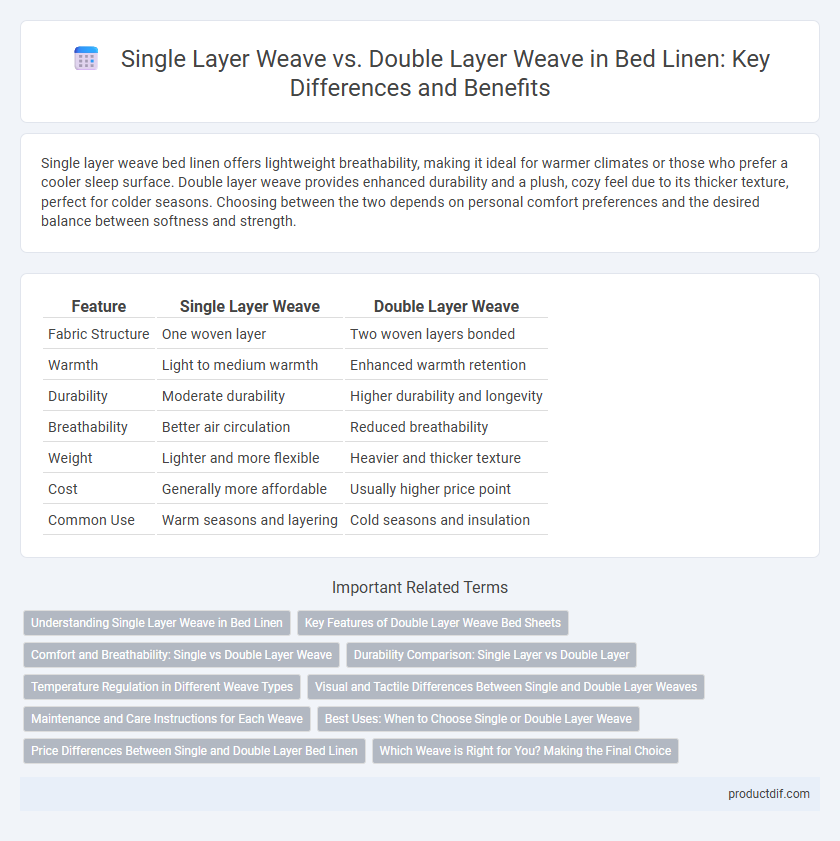Single layer weave bed linen offers lightweight breathability, making it ideal for warmer climates or those who prefer a cooler sleep surface. Double layer weave provides enhanced durability and a plush, cozy feel due to its thicker texture, perfect for colder seasons. Choosing between the two depends on personal comfort preferences and the desired balance between softness and strength.
Table of Comparison
| Feature | Single Layer Weave | Double Layer Weave |
|---|---|---|
| Fabric Structure | One woven layer | Two woven layers bonded |
| Warmth | Light to medium warmth | Enhanced warmth retention |
| Durability | Moderate durability | Higher durability and longevity |
| Breathability | Better air circulation | Reduced breathability |
| Weight | Lighter and more flexible | Heavier and thicker texture |
| Cost | Generally more affordable | Usually higher price point |
| Common Use | Warm seasons and layering | Cold seasons and insulation |
Understanding Single Layer Weave in Bed Linen
Single layer weave in bed linen features a single set of threads woven together to create a lightweight, breathable fabric ideal for warm climates or those preferring minimal texture. This weave allows enhanced airflow, promoting temperature regulation and moisture-wicking properties that contribute to a comfortable sleeping experience. The simplicity of a single layer weave results in lower production costs and easier maintenance, making it a popular choice for everyday bedding.
Key Features of Double Layer Weave Bed Sheets
Double layer weave bed sheets feature two intertwined fabric layers that enhance durability and provide a plush, cushioned feel compared to single layer weave. This construction improves thermal insulation, making them ideal for cooler climates or year-round comfort. Their increased thickness also contributes to superior wrinkle resistance and long-lasting texture retention.
Comfort and Breathability: Single vs Double Layer Weave
Single layer weave bed linen offers superior breathability, making it ideal for warm climates and those who tend to sleep hot, as it allows air to circulate freely and wick moisture away efficiently. Double layer weave provides enhanced comfort through added thickness and softness, offering better insulation and a cozy feel, especially suitable for cooler environments. Choosing between single and double layer weave depends on personal comfort preferences and climate considerations, balancing breathability with warmth.
Durability Comparison: Single Layer vs Double Layer
Double layer weave bed linen offers significantly greater durability compared to single layer weave fabrics due to its reinforced structure and increased thread count, which resists wear and tear more effectively. Single layer weaves tend to wear out faster, showing signs of thinning and fraying after fewer wash cycles, whereas double layer weaves maintain their integrity and softness over time. Investing in double layer weave bed linen ensures longer-lasting performance and sustained comfort, making it ideal for heavy use and frequent laundering.
Temperature Regulation in Different Weave Types
Single layer weave bed linens offer enhanced breathability by allowing more air circulation, making them ideal for warmer climates or those who tend to overheat at night. Double layer weave fabrics trap more air between layers, providing better insulation and warmth, which is advantageous in cooler environments. The choice between single and double layer weave significantly impacts temperature regulation, influencing sleep comfort based on individual thermal preferences.
Visual and Tactile Differences Between Single and Double Layer Weaves
Single layer weave bed linens offer a lightweight, breathable texture with a smooth surface that displays subtle weave patterns, enhancing visual simplicity and a softer hand feel. Double layer weaves present a more textured appearance with pronounced depth and intricate patterns, creating a plush and insulated touch ideal for cooler climates. The tactile contrast lies in single layers feeling crisp and cool, while double layers provide a denser, cushioned experience that adds warmth and luxury.
Maintenance and Care Instructions for Each Weave
Single layer weave bed linens require gentle machine washing in cold water with mild detergent to preserve fabric integrity, while avoiding bleach and high heat drying to prevent shrinkage and wear. Double layer weave linens demand more delicate care, including hand washing or using the delicate cycle, with air drying recommended to maintain the layered structure and ensure longevity. Both weaves benefit from ironing on low heat and storing in a cool, dry place to avoid fabric damage and discoloration.
Best Uses: When to Choose Single or Double Layer Weave
Single layer weave bed linen is ideal for warm climates and summer use due to its lightweight and breathable properties, ensuring optimal airflow and comfort. Double layer weave offers enhanced durability and insulation, making it perfect for colder seasons and heavy sleepers who need extra warmth. Choose single layer when prioritizing breathability and quick drying, and double layer for longevity and superior warmth retention.
Price Differences Between Single and Double Layer Bed Linen
Single layer bed linen typically costs less due to simpler manufacturing processes and lower material usage, making it a budget-friendly option. Double layer bed linen demands more fabric and intricate weaving techniques, resulting in higher production costs and a premium price point. Consumers often weigh durability and comfort enhancements of double layer fabrics against the affordability of single layer alternatives when choosing bed linen.
Which Weave is Right for You? Making the Final Choice
Single layer weave bed linen offers lightweight breathability ideal for warm climates or those who prefer a cooler sleep. Double layer weave provides enhanced durability and insulation, perfect for colder environments or those seeking a cozier feel. Choosing the right weave depends on your climate preferences, desired comfort level, and maintenance considerations.
Single Layer Weave vs Double Layer Weave Infographic

 productdif.com
productdif.com